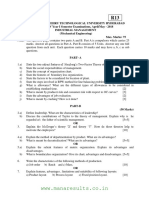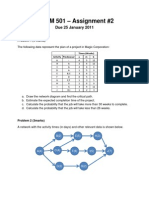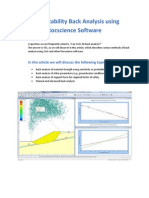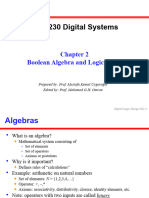9A01710 Construction Technology and Project Management
9A01710 Construction Technology and Project Management
Uploaded by
Reddy Kiran KDCopyright:
Available Formats
9A01710 Construction Technology and Project Management
9A01710 Construction Technology and Project Management
Uploaded by
Reddy Kiran KDOriginal Description:
Copyright
Available Formats
Share this document
Did you find this document useful?
Is this content inappropriate?
Copyright:
Available Formats
9A01710 Construction Technology and Project Management
9A01710 Construction Technology and Project Management
Uploaded by
Reddy Kiran KDCopyright:
Available Formats
1
Code: 9A01710
B.Tech IV Year I Semester (R09) Regular & Supplementary Examinations December/January 2013/14
CONSTRUCTION TECHNOLOGY & PROJECT MANAGEMENT
(Civil Engineering)
Time: 3 hours
Max. Marks: 70
Answer any FIVE questions
All questions carry equal marks
*****
1 (a) Describe the characteristics of a megaproject. Explain why are megaprojects often
controversial.
(b) A crew of five masons takes 8 hours to build a wall consisting of 1000 blocks. Express the
productivity in terms of blocks per man-hour.
2
Assume that you have examined the different types of non-traditional construction and have
learned about a range of problems which may arise. Review those identified problems and try
to generalize those which non-traditional properties may share.
Soil classification should not be regarded as an end in itself but as a tool to enhance your
knowledge of soil behavior. Comment on this statement and describe the classification of
soils.
The type of explosive used in any project depends on the hardness and structural
characteristics of the rock and overall geometry of the cut. Comment on this statement with
different examples of explosives.
5 (a) Both schedules and budgets are necessary parts of any plan. What do you think is the
backbone of any good schedule or budget? Justify your answer.
(b) Discuss the responsibilities for key members in the project team.
6 (a) Explain about work break down structures in detail with an example.
(b) Explain what precedence diagramming methods are and how they can be used to understand
project duration and flexibility.
Contd. in page 2
Page 1 of 2
Code: 9A01710
7
A project consists of the following activities and time estimates.
a) Find the expected time and the variance for each activity.
b) What is the probability that the project will be completed 4 weeks earlier that the expected
time?
c) What is the probability that the project will be completed in 19 weeks?
Activity
(1,2)
(1,3)
(1,4)
(2,5)
(3,5)
(4,6)
(5,6)
Estimated duration in weeks
Optimistic
Most likely
Pessimistic
1
1
7
1
4
7
2
2
8
1
1
1
2
5
14
2
5
8
3
6
15
A network consists of following list. Times are given in weeks.
Activity
A
B
C
D
E
F
G
H
Preceding
--A, B
B
C
D, E
F
Optimistic
5
3
6
3
4
6
2
3
Probable
11
3
10
5
6
8
4
3
Pessimistic
14
9
14
7
11
13
6
9
a) Draw the network diagram.
b) Calculate the expected duration and variance of each activity.
c) Calculate the expected duration and variance of the critical path.
d) Calculate the probability that the project will be completed in less than 28 weeks.
*****
Page 2 of 2
Code: 9A01710
B.Tech IV Year I Semester (R09) Regular & Supplementary Examinations December/January 2013/14
CONSTRUCTION TECHNOLOGY & PROJECT MANAGEMENT
(Civil Engineering)
Time: 3 hours
Max. Marks: 70
Answer any FIVE questions
All questions carry equal marks
*****
1 (a) Are designers selected through competitive bidding. Describe the basis for their selection.
(b) How does value engineering allow cost sharing of savings during a project? What construction
party identifies savings during construction?
2
What the requirements and suitability of systems for modern methods of construction (MMC)?
Explain the types of MMC.
Describe the trenchless technologies in pipeline construction.
4 (a) Explain the different types of drilling methods.
(b) Differentiate between downhole drilling rig and percussion/track drilling rig.
5 (a) Explain the main cause of project failure.
(b) Discuss the roles of project manager in detail.
6 (a) Explain why the critical path is the longest, not the shortest, path through a network.
(b) Discuss the cost trade-off in project crashing.
Contd. in page 2
Page 1 of 2
Code: 9A01710
7
A partially solved PERT problem is detailed in the table below. Times are give in weeks
(a) Calculate the expected time for each activity. Enter these values in the appropriate column
in the table above.
(b) Which activities form the critical path?
(c) What is the estimated time of the critical path?
(d) What are the project variance and the project standard deviation?
(e) What is the probability of completion of the project after week 40?
Activity
Preceding
A
B
C
D
E
F
G
H
I
J
K
-A
A
A
B
B
C, F
D
H
G, I
E, J
Optimistic
Time
7
2
8
3
4
6
2
2
6
4
2
Probable
Time
9
2
12
5
6
8
3
2
8
6
2
Pessimistic
Time
14
8
16
10
8
10
4
8
16
14
5
Expected
Time
variance
1.361
0
0
1.361
0
0
0
1.000
2.778
2.778
0.250
The following table gives the cost particulars of a project. If the indirect cost is Rs. 100 per
day, find the least cost schedule.
Activity
(1, 2)
(1, 3)
(2, 4)
(2, 5)
(3, 4)
(4, 5)
Normal
Time
(days)
8
4
2
10
5
3
Cost
(Rs)
100
150
50
100
100
80
Crash
Time
(days)
6
2
1
5
1
1
Cost
(Rs)
200
350
90
100
200
100
*****
Page 2 of 2
T
2
2
1
5
4
2
100
200
40
300
100
20
Code: 9A01710
B.Tech IV Year I Semester (R09) Regular & Supplementary Examinations December/January 2013/14
CONSTRUCTION TECHNOLOGY & PROJECT MANAGEMENT
(Civil Engineering)
Time: 3 hours
Max. Marks: 70
Answer any FIVE questions
All questions carry equal marks
*****
1 (a) Describe the role of owner, designer and contractor in the construction process.
(b) What documents describe the design of a construction project? How do they differ? Explain.
2 (a) Explain the construction equipment deployed in large scale building works.
(b) Describe the factors influences during a site selection. Explain with a infrastructure
development project.
3
Use of mechanized equipment poses significant crushing and striking hazards during
excavation works. Elaborate.
4 (a) Describe the effect of geologic structure on blasting procedure.
(b) Explain the different methods of blasting.
5 (a) Effective control systems identify deviations from project plans and commitments early
enough to eliminate surprises and allow correction Explain this statements.
(b) Explain the project development process.
6 (a) Discuss the guidelines for constructing a project network.
(b) Distinguish between resource leveling and resource allocation.
Contd. in page 2
Page 1 of 2
Code: 9A01710
7 (a) A network consists of the following list. Times are given in weeks.
(i) Draw the network diagram.
(ii) Calculate the expected duration and variance of each activity.
(iii) Calculate the expected duration and variance of the critical path.
(iv) Calculate the probability that the project will be completed in less than 28 weeks.
Activity
A
B
C
D
E
F
G
H
Preceding
--A, B
B
C
D, E
F
Optimistic
5
3
6
3
4
6
2
3
Probable
11
3
10
5
6
8
4
3
Pessimistic
14
9
14
7
11
13
6
9
(b) Three activities are candidates for crashing on a CPM network. Activity details are in the table
below.
Activity
A
B
C
Normal Time
9 days
5 days
12 days
Normal Cost
Rs 8,000
Rs 2,000
Rs 9,000
Crash Duration
7 days
3 days
11 days
Crash Cost
Rs 12,000
Rs 10,000
Rs 12,000
(i) What is the crash cost per unit time for activity A?
(ii) What is the crash cost per unit time for activity B?
(iii) Which activity should be crashed first to cut one day from the projects duration; how much
is added to project cost?
(iv) Which activity should be the next activity crashed to cut a second day from the projects
duration; how much is added to project cost?
(v) Assuming no other paths become critical, how much can this project be shortened at what
total added cost?
8 (a) Three activities are candidates for crashing on a CPM network. Activity details are in the table
below.
(i) What is the crash cost per unit time for each of the three activities?
(ii) Which activity should be crashed first to cut one day from the projects duration; how much
is added to project cost?
(iii) Which activity should be the next activity crashed to cut a second day from the projects
duration; how much is added to project cost?
Activity
X
Y
Z
Normal Time
8 days
3 days
12 days
Normal Cost
Rs 6,000
Rs 1,800
Rs 5,000
Crash Duration
6 days
2 days
9 days
Crash cost
Rs 8,000
Rs 2,400
Rs 7,700
(b) How is the expected completion time of project activity, and of a PERT project, computed?
*****
Page 2 of 2
Code: 9A01710
B.Tech IV Year I Semester (R09) Regular & Supplementary Examinations December/January 2013/14
CONSTRUCTION TECHNOLOGY & PROJECT MANAGEMENT
(Civil Engineering)
Time: 3 hours
Max. Marks: 70
Answer any FIVE questions
All questions carry equal marks
*****
1 (a) How is the construction industry different from a manufacturing industry? Explain.
(b) Can a contractor refuse to do change order work. Explain.
2 (a) Explain the concept of prefabrication in construction. How it is essential to a large scale
project.
(b) Elaborate the necessity of false work and temporary works in an office building.
3
Elaborate the significant development in pipeline construction.
4 (a) Explain; (i) production blasting and (ii) controlled blasting
(b) Describe the advantages and limitations of common excavation practices.
5 (a) Project controls system provides timely information for proactive construction management.
Explain in detail.
(b) Explain the basic concepts in the development of construction plans.
6 (a) It has been said the WBS and Gantt charts are each useful tools, but neither is complete for
managing projects. What is missing from one that is present in the other so that the two tools
are complementary? Discuss.
(b) What are some of the ethical issues faced by project managers? Which of these are likely to
occur before a project begins, which are likely to occur while the project is underway, and
which may occur after a project is complete? Illustrate any one of these from recent new.
Contd. in page 2
Page 1 of 2
Code: 9A01710
7
The network below represents a project being analyzed by critical path methods. Activity
durations are indicated on the network.
a) Identify the activities on the critical path.
b) What is the duration of the critical path?
c) Calculate the amount of slack time at activity H.
d) If activity I were delayed by ten time units, What would be the impact on the project
duration.
11
End
E
Start
B
3
I
5
G
4
D
4
F
6
H
3
Consider the network described in the table below.
Activity
J
K
L
M
N
O
P
Immediate
Predecessor(s)
--J
J
K, M
K, M
L, N
Pessimistic
Probable
Optimistic
15
9
10
3
9
10
10
10
8
6
3
5
7
8
8
7
5
3
1
4
3
(a) Calculate the expected duration of each activity.
(b) Calculate the expected duration and variance of the critical path.
(c) Calculate the probability that the project will be completed in fewer than 30 time units.
*****
Page 2 of 2
You might also like
- 9A01709 Advanced Structural Analysis PDFDocument8 pages9A01709 Advanced Structural Analysis PDFReddy Kiran KDNo ratings yet
- Subject: B. Tech (Computer Science & Engineering) Paper Name: Project Management Paper Code: HU801B FM: 70 Time: 3 HoursDocument4 pagesSubject: B. Tech (Computer Science & Engineering) Paper Name: Project Management Paper Code: HU801B FM: 70 Time: 3 HoursVikas Kumar100% (1)
- Course Code: CET 408 Gths/Rs - 19 / 7604 Eighth Semester B. E. (Civil Engineering) ExaminationDocument3 pagesCourse Code: CET 408 Gths/Rs - 19 / 7604 Eighth Semester B. E. (Civil Engineering) ExaminationRajput Ayush ThakurNo ratings yet
- FinalExam ICT481 2019Document6 pagesFinalExam ICT481 2019Michael SinkambaNo ratings yet
- Be Winter 2022Document3 pagesBe Winter 2022fwzf2b7kkvNo ratings yet
- Civil - IV I BCEDocument53 pagesCivil - IV I BCEAnonymous 8EYiR2EGQNo ratings yet
- Exam PM NOV 2022 IMavec Correction QCMDocument5 pagesExam PM NOV 2022 IMavec Correction QCMNajet KasmiNo ratings yet
- Fce 472 ExamDocument7 pagesFce 472 ExamVICTOR MWANGINo ratings yet
- Mba MB 401 Project Management and Entrepreneurship Development 2011Document7 pagesMba MB 401 Project Management and Entrepreneurship Development 2011RajeshNo ratings yet
- Civil Engineering Project Management KTU Model QuestionDocument2 pagesCivil Engineering Project Management KTU Model Questionshalu R FNo ratings yet
- 06spm l02Document12 pages06spm l02akram1978No ratings yet
- Tugasan Project Management Homework Answers PDFDocument4 pagesTugasan Project Management Homework Answers PDFsavannaheyzNo ratings yet
- Code: 20PM01T: Register NumberDocument17 pagesCode: 20PM01T: Register Numbermallikarjunshorapur991No ratings yet
- Course Code: CET 408 Irjq/Ms - 19 / 8604 Eighth Semester B. E. (Civil Engineering) ExaminationDocument3 pagesCourse Code: CET 408 Irjq/Ms - 19 / 8604 Eighth Semester B. E. (Civil Engineering) ExaminationRajput Ayush ThakurNo ratings yet
- CTM Mid - 1 PDFDocument5 pagesCTM Mid - 1 PDFGurunath GunturNo ratings yet
- GRE 502 19 - QuestionDocument3 pagesGRE 502 19 - Questionajiejohn56No ratings yet
- Path AnalysisDocument3 pagesPath AnalysisRakesh bhukyaNo ratings yet
- Ce 41 Ce 401 2021Document3 pagesCe 41 Ce 401 2021Anvari RahmanNo ratings yet
- MCQs - Project Planning and Management - 39823393 - 2024 - 08 - 15 - 23 - 00Document26 pagesMCQs - Project Planning and Management - 39823393 - 2024 - 08 - 15 - 23 - 00svcomputermudalNo ratings yet
- Akshay Mehta Semester 8 Roll no-TEN1605004 Project Planning Control Assignment UNIT-2Document19 pagesAkshay Mehta Semester 8 Roll no-TEN1605004 Project Planning Control Assignment UNIT-2Akshay MehtaNo ratings yet
- Project Management SMT 2 2018Document8 pagesProject Management SMT 2 2018Almas Pratama IndrastiNo ratings yet
- Bit2305 Ict Project Management Bbit204 It Project Management BacDocument3 pagesBit2305 Ict Project Management Bbit204 It Project Management Bacgracevalerie1No ratings yet
- PM Past PaperDocument2 pagesPM Past PaperŠhákéèl ßûghÿoNo ratings yet
- QUESTION FOR T5 Project ManagementDocument2 pagesQUESTION FOR T5 Project ManagementFazlina SamatNo ratings yet
- Take Home Quizz - Exec HMDocument5 pagesTake Home Quizz - Exec HMbeshfrend'z0% (1)
- Project Planning NotesDocument13 pagesProject Planning NotesEljah NjoraNo ratings yet
- NICMAR Exam Ques Paper - June 2010Document10 pagesNICMAR Exam Ques Paper - June 2010Vithal Katrodiya100% (6)
- Construction Management and Entrepreneurship: Model Question Paper - With Effect From 2020-21 (CBCS Scheme)Document3 pagesConstruction Management and Entrepreneurship: Model Question Paper - With Effect From 2020-21 (CBCS Scheme)Praveen KumarNo ratings yet
- Project ManagementDocument16 pagesProject Managementसुजन कार्कीNo ratings yet
- ADL 14 Ver2+Document9 pagesADL 14 Ver2+DistPub eLearning Solution33% (3)
- 117 DV 052018Document2 pages117 DV 052018chiranjeevi kindinlaNo ratings yet
- Assignment 6 - Project Management, Project Life Cycle and Critical Path MethodDocument6 pagesAssignment 6 - Project Management, Project Life Cycle and Critical Path MethodPratik PatilNo ratings yet
- Gujarat Technological UniversityDocument2 pagesGujarat Technological Universityvifaket581No ratings yet
- FE Old Questions and Answers (Time Management)Document4 pagesFE Old Questions and Answers (Time Management)Khun Aung Paing50% (2)
- Page 1 of 4Document4 pagesPage 1 of 4Elzubair Eljaali100% (1)
- BUSI4135 - Sample Exam Paper 2024Document5 pagesBUSI4135 - Sample Exam Paper 2024talha77050No ratings yet
- CPM OCT Questions and AnswersDocument2 pagesCPM OCT Questions and Answersഅൻവർ അൻവർNo ratings yet
- CB510 Final Exam F20-21Document4 pagesCB510 Final Exam F20-21HEsham NoubyNo ratings yet
- Construction Management and Entrepreneurship: Model Question Paper - With Effect From 2020-21 (CBCS Scheme)Document3 pagesConstruction Management and Entrepreneurship: Model Question Paper - With Effect From 2020-21 (CBCS Scheme)Monika AcharyaNo ratings yet
- Ass 2Document2 pagesAss 2Ankush Jakhmola67% (3)
- Optimistic Most Likely PessimisticDocument5 pagesOptimistic Most Likely PessimisticDebayan GhoshNo ratings yet
- Quiz 11Document7 pagesQuiz 11hanoma.156No ratings yet
- R5321502-Mathematical Modeling & SimulationDocument1 pageR5321502-Mathematical Modeling & SimulationIbmWasuserNo ratings yet
- Me6146D Project Managementstatistics: National Institute of Technology Calicut School of Management StudiesDocument3 pagesMe6146D Project Managementstatistics: National Institute of Technology Calicut School of Management StudiesSunilNo ratings yet
- Course Code: CET 408 Kolp/Rw - 19 / 9605 Eighth Semester B. E. (Civil Engineering) ExaminationDocument3 pagesCourse Code: CET 408 Kolp/Rw - 19 / 9605 Eighth Semester B. E. (Civil Engineering) ExaminationanonymousNo ratings yet
- Mba MB 401 Project Management and Entrepreneurship Development 2010Document4 pagesMba MB 401 Project Management and Entrepreneurship Development 2010Shreya SarkarNo ratings yet
- IT4204 - IT Project Management: University of Colombo, Sri LankaDocument7 pagesIT4204 - IT Project Management: University of Colombo, Sri LankaWipuli Lochana DisanayakeNo ratings yet
- CH 03 PPDocument5 pagesCH 03 PPSagar PandeyNo ratings yet
- HBC 2404 Project ManagementDocument2 pagesHBC 2404 Project Managementgesarevivian21No ratings yet
- Project Management-0406Document18 pagesProject Management-0406api-3776226No ratings yet
- Paper Sem7Document42 pagesPaper Sem7Sandip BudhathokiNo ratings yet
- HCS403 Nov 2018Document3 pagesHCS403 Nov 2018RYAN GAMBINGANo ratings yet
- M.E. (Civil) Examination Nov-Dec 2011 615 CCM: Scheduling of Construction Projects Time: Three Hours Max. Marks: 100 Min. Pass Marks: 40Document2 pagesM.E. (Civil) Examination Nov-Dec 2011 615 CCM: Scheduling of Construction Projects Time: Three Hours Max. Marks: 100 Min. Pass Marks: 40Sanjay TiwariNo ratings yet
- SST101e JAN 2021 TOA PDFDocument6 pagesSST101e JAN 2021 TOA PDFJulyhah JulaihahNo ratings yet
- School of Energy, Geoscience, Infrastructure & Society Construction Project ManagementDocument3 pagesSchool of Energy, Geoscience, Infrastructure & Society Construction Project ManagementAmir_Jamal_Qureshi100% (1)
- B.sc. Engineering 3.1, 2017Document14 pagesB.sc. Engineering 3.1, 2017MD SHAKIL AHMEDNo ratings yet
- The New 3D Layout for Oil & Gas Offshore Projects: How to ensure successFrom EverandThe New 3D Layout for Oil & Gas Offshore Projects: How to ensure successRating: 4.5 out of 5 stars4.5/5 (3)
- Beginner’S Project Management Handbook: Art of Project DeliveryFrom EverandBeginner’S Project Management Handbook: Art of Project DeliveryNo ratings yet
- R7420103 Environmental Impact Assessment & ManagementDocument1 pageR7420103 Environmental Impact Assessment & ManagementReddy Kiran KDNo ratings yet
- 15699A0477 1dDocument4 pages15699A0477 1dReddy Kiran KDNo ratings yet
- Answer & ExplanationsDocument3 pagesAnswer & ExplanationsReddy Kiran KDNo ratings yet
- R7420201 Utilization of Electrical EnergyDocument1 pageR7420201 Utilization of Electrical EnergyReddy Kiran KDNo ratings yet
- R7420501 Management ScienceDocument1 pageR7420501 Management ScienceReddy Kiran KDNo ratings yet
- R7420201 Utilization of Electrical EnergyDocument1 pageR7420201 Utilization of Electrical EnergyReddy Kiran KDNo ratings yet
- R7420401 Optical CommunicationsDocument1 pageR7420401 Optical CommunicationsReddy Kiran KDNo ratings yet
- R7420301 Production Planning & ControlDocument1 pageR7420301 Production Planning & ControlReddy Kiran KDNo ratings yet
- R7420101 Advanced Structural DesignDocument1 pageR7420101 Advanced Structural DesignReddy Kiran KDNo ratings yet
- R7420102 Ground Water Development & ManagementDocument1 pageR7420102 Ground Water Development & ManagementReddy Kiran KDNo ratings yet
- JNTUA B.tech 4-1 ECE R13 Syllabus BookDocument23 pagesJNTUA B.tech 4-1 ECE R13 Syllabus BookReddy Kiran KDNo ratings yet
- 9A05703 Grid and Cluster Computing PDFDocument4 pages9A05703 Grid and Cluster Computing PDFReddy Kiran KDNo ratings yet
- Online Electricity Bill Payment: Thank You!Document1 pageOnline Electricity Bill Payment: Thank You!Reddy Kiran KDNo ratings yet
- Online Electricity Bill Payment: Thank You!Document1 pageOnline Electricity Bill Payment: Thank You!Reddy Kiran KDNo ratings yet
- 9A01709 Advanced Structural AnalysisDocument8 pages9A01709 Advanced Structural AnalysisReddy Kiran KD0% (1)
- 9A02709 Optimization TechniquesDocument4 pages9A02709 Optimization TechniquesReddy Kiran KDNo ratings yet
- Visual SymbolsDocument39 pagesVisual Symbolsbt17No ratings yet
- CCP303Document19 pagesCCP303api-3849444No ratings yet
- PHYS 237 Syllabus 2014Document2 pagesPHYS 237 Syllabus 2014spylogo3No ratings yet
- Alv EditDocument7 pagesAlv EditdncvaNo ratings yet
- Slope Stability Back Analysis Methods Using Rocscience SoftwareDocument10 pagesSlope Stability Back Analysis Methods Using Rocscience SoftwareMiguel CadenaNo ratings yet
- Kushyar - S ArithmeticsDocument21 pagesKushyar - S ArithmeticsmohammedNo ratings yet
- Computer Graphics: B.E. (Computer Science Engineering) Fifth Semester (C.B.S.)Document2 pagesComputer Graphics: B.E. (Computer Science Engineering) Fifth Semester (C.B.S.)Akash RautNo ratings yet
- PRJ Report Juan ZapataDocument14 pagesPRJ Report Juan ZapataorangeskyenNo ratings yet
- MainDocument134 pagesMainIndrajNo ratings yet
- Parabola Workbook Pattern-2Document6 pagesParabola Workbook Pattern-2Mayank GoyalNo ratings yet
- Fa14-Mth321 ch01 PDFDocument15 pagesFa14-Mth321 ch01 PDFSehar MalikNo ratings yet
- Maa SL: Suggested Teaching Order ForDocument3 pagesMaa SL: Suggested Teaching Order ForHui ZhengNo ratings yet
- Laminate Theory: Laminated PlateDocument22 pagesLaminate Theory: Laminated PlateJuan CarlosNo ratings yet
- PGP-Data Science - Course Module With Internship ModuleDocument17 pagesPGP-Data Science - Course Module With Internship ModuleMehulkumar HireNo ratings yet
- Ecology Odum Chapter 1Document13 pagesEcology Odum Chapter 1tanzeercaur0% (2)
- A Tutorial On TEM Transmission LinesDocument5 pagesA Tutorial On TEM Transmission Linesgak_16168601No ratings yet
- Introecon Normal Dist PDFDocument22 pagesIntroecon Normal Dist PDFFetsum LakewNo ratings yet
- Methods of Inference: Expert Systems: Principles and Programming, Fourth EditionDocument60 pagesMethods of Inference: Expert Systems: Principles and Programming, Fourth EditionEmran AljarrahNo ratings yet
- Momentum Practice Problems: Physics Chapter 8Document23 pagesMomentum Practice Problems: Physics Chapter 8Sander PoldoNo ratings yet
- Martin Bland - An Introduction To Medical Statistics-OUP Oxford (2015) PDFDocument447 pagesMartin Bland - An Introduction To Medical Statistics-OUP Oxford (2015) PDFNitesh Kumar100% (1)
- Topic 1 - Number and Algebra MARKSCHEMEDocument27 pagesTopic 1 - Number and Algebra MARKSCHEMEelysia.pwisNo ratings yet
- Thesis Using Multiple Linear RegressionDocument7 pagesThesis Using Multiple Linear Regressiontmexyhikd100% (2)
- SPP Technical PaperDocument3 pagesSPP Technical PaperMarian Galvez-LuisNo ratings yet
- Chapter 2 Boolean Algebra and Logic GatesDocument54 pagesChapter 2 Boolean Algebra and Logic GatesMariam202No ratings yet
- WBUT 5th SEMESTER SYLLABUS CSE 2012Document14 pagesWBUT 5th SEMESTER SYLLABUS CSE 2012Ritwick HalderNo ratings yet
- Motion in A Straight Line - DPP 01 (Of Lec 02) - Arjuna JEE 2.0 2024Document2 pagesMotion in A Straight Line - DPP 01 (Of Lec 02) - Arjuna JEE 2.0 2024yadavsatyam8415No ratings yet
- Modeling of Two Wheel Balancing RobotDocument7 pagesModeling of Two Wheel Balancing RobotAbdullah AhmedNo ratings yet
- Capsule Notes - 5th BRMDocument35 pagesCapsule Notes - 5th BRMvaishnavvktNo ratings yet
- Analysis of Phase-Locked Loop Influence On The Stability of Single-Phase Grid-Connected InverterDocument8 pagesAnalysis of Phase-Locked Loop Influence On The Stability of Single-Phase Grid-Connected InverterKGOTSO MORABANo ratings yet








































































































